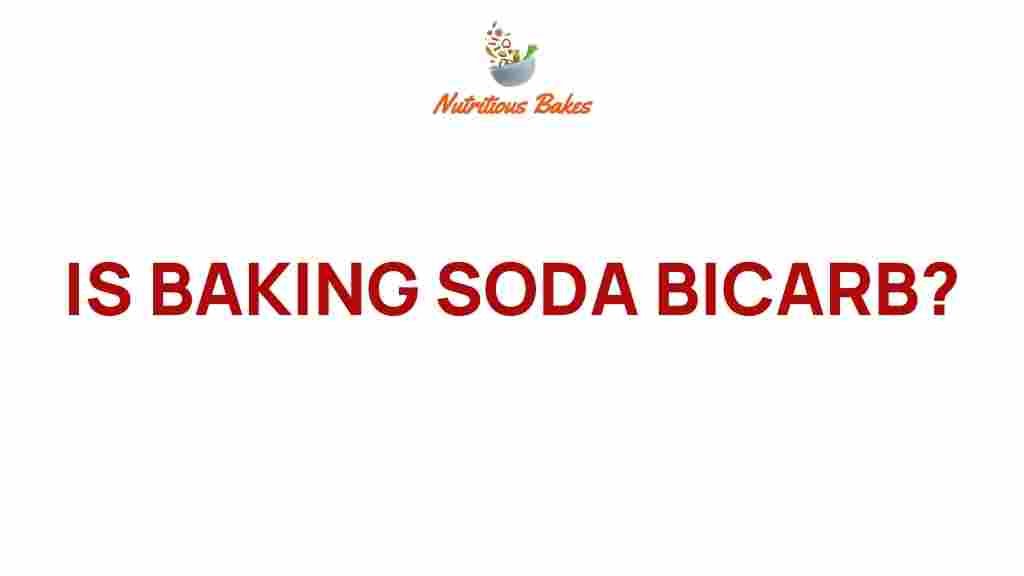The Surprising Truth: Is Baking Soda the Same as Bicarbonate of Soda?
When you step into the kitchen, you might find yourself surrounded by a variety of ingredients, each playing a crucial role in cooking and baking. Among these pantry staples, two terms often come up: baking soda and bicarbonate of soda. Are they the same? This article delves deep into the essence of these ingredients, exploring their uses, benefits, and their roles in food science.
Understanding Baking Soda and Bicarbonate of Soda
Baking soda and bicarbonate of soda refer to the same chemical compound, sodium bicarbonate (NaHCO₃). This versatile ingredient is a popular leavening agent, which means it helps baked goods rise, creating that light and fluffy texture we all adore. But how does it work?
When baking soda is combined with an acid (like vinegar, lemon juice, or yogurt), it undergoes a chemical reaction that produces carbon dioxide gas. This gas forms bubbles in the batter or dough, causing it to expand and rise during baking.
The Role of Baking Soda in Cooking
In the culinary world, baking soda is a game changer. Here are some of its primary uses:
- Leavening Agent: As mentioned, baking soda is essential for making cakes, cookies, and breads rise.
- pH Regulator: It can help control acidity levels in recipes, balancing flavors.
- Color Enhancer: Baking soda can enhance the color of certain baked goods, making them more visually appealing.
- Texture Modifier: It improves the texture of baked products, giving them a desirable mouthfeel.
Health Benefits of Baking Soda
Beyond the kitchen, baking soda has several health benefits:
- Antacid Properties: It can neutralize stomach acid, providing relief from heartburn and indigestion.
- Oral Health: Baking soda can help whiten teeth and freshen breath when used in toothpaste.
- Skin Care: It can be used in DIY scrubs to exfoliate the skin and soothe irritations.
Cooking with Baking Soda: Tips and Tricks
To make the most of baking soda in your cooking, consider these tips:
- Measure Correctly: Too much baking soda can lead to a soapy taste in your baked goods.
- Pair with Acids: Always combine baking soda with an acid to activate its leavening properties.
- Freshness Matters: Baking soda can lose potency over time. Check the expiration date and perform a freshness test by mixing a teaspoon with vinegar; it should fizz vigorously if fresh.
Common Uses of Bicarbonate of Soda in the Kitchen
While the terms baking soda and bicarbonate of soda are interchangeable, here are some specific uses for bicarbonate of soda in the kitchen:
- Fluffier Pancakes: Add a pinch of baking soda to pancake batter for extra fluffiness.
- Brown Sugar Softener: To keep brown sugar soft, mix a small amount of baking soda into the container.
- Vegetable Cleaner: Use baking soda to wash vegetables and fruits; it helps remove dirt and pesticides.
Step-by-Step Process: Using Baking Soda in Baking
Here’s a simple guide to using baking soda in your baking endeavors:
- Gather Your Ingredients: Ensure you have baking soda, an acid, and your other ingredients ready.
- Mix Dry Ingredients: In a bowl, combine flour, baking soda, and any other dry ingredients.
- Incorporate Wet Ingredients: In a separate bowl, mix your wet ingredients (like milk or yogurt) and any acidic ingredients (like vinegar or lemon juice).
- Combine Mixtures: Gradually add the wet mixture to the dry ingredients, stirring gently to avoid over-mixing.
- Bake Immediately: Pour the batter into a prepared pan and bake as directed. The chemical reaction begins immediately, so don’t wait!
Troubleshooting Common Baking Soda Issues
Even the most seasoned bakers might run into issues when using baking soda. Here are some common problems and solutions:
- Flat Baked Goods: This could be due to expired baking soda. Ensure it’s fresh and properly measured.
- Soapy Taste: Overuse of baking soda can lead to a soapy flavor. Stick to the recipe measurements.
- Discoloration: If your baked goods turn brown too quickly, consider adjusting the oven temperature or baking time.
Exploring Food Science: The Chemistry Behind Baking Soda
Baking soda’s effectiveness as a leavening agent is rooted in its chemical properties. The reaction between baking soda and acids releases carbon dioxide gas, which forms bubbles. This is a classic example of a chemical reaction in cooking.
Understanding the science behind baking soda can enhance your cooking skills, allowing you to adjust recipes and troubleshoot issues effectively.
Storage Tips for Baking Soda
To keep your baking soda fresh and effective:
- Store in a Cool, Dry Place: Keep it away from moisture and heat sources.
- Airtight Container: Transfer it to an airtight container to prevent it from absorbing odors from the pantry.
- Label and Date: Mark the container with the purchase date to track its freshness.
Conclusion: Baking Soda vs. Bicarbonate of Soda
In conclusion, baking soda and bicarbonate of soda are indeed the same ingredient, essential for various cooking and baking tasks. Recognizing its role as a powerful leavening agent can significantly impact your baking results. Whether you’re whipping up a batch of cookies or tackling a new recipe, understanding how to use this pantry staple properly will elevate your culinary skills.
With its myriad of health benefits and versatile applications, baking soda is not just a kitchen ingredient; it’s a vital tool in food science. So the next time you reach for that box of baking soda, you’ll know the surprising truth—it’s a powerhouse of potential just waiting to be unleashed in your kitchen!
This article is in the category Ingredients and created by NutritiousBakes Team
